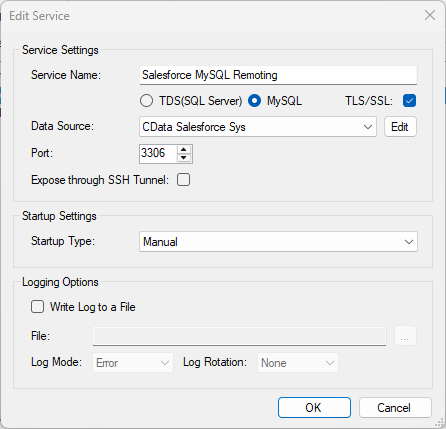Discover how a bimodal integration strategy can address the major data management challenges facing your organization today.
Get the Report →How to Query Databricks Data in MySQL Workbench
Execute MySQL queries against live Databricks data from MySQL Workbench.
You can use the SQL Gateway from the ODBC Driver for Databricks to query Databricks data through a MySQL interface. Follow the procedure below to start the MySQL remoting service of the SQL Gateway and work with live Databricks data in MySQL Workbench.
Connect to Databricks Data
If you have not already done so, provide values for the required connection properties in the data source name (DSN). You can use the built-in Microsoft ODBC Data Source Administrator to configure the DSN. This is also the last step of the driver installation. See the "Getting Started" chapter in the help documentation for a guide to using the Microsoft ODBC Data Source Administrator to create and configure a DSN.
To connect to a Databricks cluster, set the properties as described below.
Note: The needed values can be found in your Databricks instance by navigating to Clusters, and selecting the desired cluster, and selecting the JDBC/ODBC tab under Advanced Options.
- Server: Set to the Server Hostname of your Databricks cluster.
- HTTPPath: Set to the HTTP Path of your Databricks cluster.
- Token: Set to your personal access token (this value can be obtained by navigating to the User Settings page of your Databricks instance and selecting the Access Tokens tab).
Configure the SQL Gateway
See the SQL Gateway Overview to set up connectivity to Databricks data as a virtual MySQL database. You will configure a MySQL remoting service that listens for MySQL requests from clients. The service can be configured in the SQL Gateway UI.

Query Databricks from MySQL Workbench
The steps below outline connecting to the virtual Databricks database created in the SQL Gateway from MySQL Workbench and issuing basic queries to work with live Databricks data.
Connect to Databricks through the SQL Gateway
- In MySQL Workbench, click to add a new MySQL connection.
- Name the connection (CData SQL Gateway for Databricks).
- Set the Hostname, Port, and Username parameters to connect to the SQL Gateway.
- Click Store in Vault to set and store the password.
- Click Test Connection to ensure the connection is configured properly and click OK.

Query Databricks Data
- Open the connection you just created (CData SQL Gateway for Databricks).
- Click File -> New Query Tab.
- Write a SQL query to retrieve Databricks data, like SELECT * FROM `CData Databricks Sys`.Customers;

With access to live Databricks data from MySQL Workbench, you can easily query and update Databricks, just like you would a MySQL database. Get started now with a free, 30-day trial of the CData ODBC Driver for Databricks and the CData SQL Gateway.






